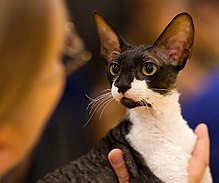Cornish Rex
| Cornish Rex | |
|---|---|
 | |
| Other names | Rex, Corny/Cornies |
| Origin | United Kingdom |
| Breed standards | |
| CFA | standard |
| FIFe | standard |
| TICA | standard |
| ACF | standard |
| ACFA/CAA | standard |
| CCA-AFC | standard |
| GCCF | standard |
| Domestic cat (Felis catus) | |
The Cornish Rex is a breed of domestic cat. The Cornish Rex has no hair except for down hair. Most breeds of cat have three different types of hair in their coats: the outer fur or "guard hairs", a middle layer called the "awn hair"; and the down hair or undercoat, which is very fine and about 1 cm long. Cornish Rexes only have the undercoat.[1] Occasional individuals are prone to hair loss or will develop a very thin coat or even go bald over large parts of their body. The curl in their fur is caused by a different mutation and gene than that of the Devon Rex. The breed originated in Cornwall, Great Britain.
Characteristics[edit]
The coat of a Cornish Rex is extremely fine and naturally curly.[2] Their light coat means that they are best suited for indoor living in warm and dry conditions, as they are sensitive to low temperatures.[citation needed]
The breed is sometimes referred to as the Greyhound of the cats, because of the sleek appearance and the galloping run characteristic of the breed.[3][better source needed]
Appearance[edit]
According to the Governing Council of the Cat Fancy (GCCF) standard, the Cornish Rex's colour is irrelevant[2] — therefore the cat may be any colour.[4]
Aside from the distinctive the coat, the Cornish Rex is set apart by its 'foreign type', slender legs and tail, oval eyes, and wedge shaped head.[2] The Cornish Rex's ears are large and wide at the base with rounded tips and are described as being almost mussel shell shaped. The eyes are medium in size and come in all varieties of eye colour. The body is slender and muscular with small paws.[2]
Genetics[edit]
In 2013, researchers identified the mutation that defines the Cornish Rex breed. Genome-wide analyses were performed in the Cornish Rex breed and in 11 phenotypically diverse breeds and two random bred populations. A gene on chromosome A1, the lysophosphatidic acid receptor 6 (LPAR6), was identified to have a 4 base pair deletion. This induces a premature stop codon in the receptor that is absent in all straight haired cats analyzed. LPAR6 encodes a receptor essential for maintaining the structural integrity of the hair shaft. In humans, LPAR6 mutations result in a form of ectodermal dysplasia characterised by a woolly hair phenotype.[5][6]
Origin[edit]
The Cornish Rex is a genetic mutation that originated from a litter of kittens born in the 1950s on a farm in Cornwall, UK.[7] One of the kittens, a cream-colored male named Kallibunker, had an extremely unusual, fine and curly coat; he was the first Cornish Rex. The owner then backcrossed Kallibunker to his mother to produce 2 other curly-coated kittens. The male, Poldhu, sired a female called Lamorna Cove who was later brought to America and crossed with a Siamese, giving the breed their long whippy tails and big ears.[citation needed]
The Devon Rex looks similar in appearance to the Cornish Rex but has guard hairs and sheds. The Devon Rex mutation is different from the Cornish Rex mutation in that the Devon has shortened guard hairs, while the Cornish Rex lacks guard hairs altogether.[8]

Hypoallergenic[edit]
Despite some belief to the contrary, the Cornish Rex's short hair does not make it non- or hypo-allergenic. Allergic reactions from cats are not the result of hair length, but from a glycoprotein known as Fel d 1, produced in the sebaceous glands of the skin, saliva, and urine.[9] Most people who have cat allergies are reacting to this protein in cat saliva and cat dander: when the cat cleans its fur, the saliva dries and is transformed into dust that people breathe in. Since Cornish Rex cats groom as much as or even more than ordinary cats, a Cornish Rex cat can still produce a reaction in people who are allergic to cats. It is, however, widely reported to cause lesser to little allergic reaction.[1]
References[edit]
- ^ a b Drummey, Kristen (20 July 2022). "What to Know About a Cornish Rex". WebMD. Retrieved 15 August 2023.
- ^ a b c d "Cornish Rex Standard" (PDF). Governing Council of the Cat Fancy. Retrieved 20 February 2024.
- ^ Animal Planet television series: "Cats 101" episode:"Colorpoint Shorthair".
- ^ "Cornish Rex". Governing Council of the Cat Fancy. Retrieved 20 February 2024.
- ^ Gandolfi, Barbara; Alhaddad, Hasan; Affolter, Verena K.; Brockman, Jeffrey; Haggstrom, Jens; Joslin, Shannon E. K.; Koehne, Amanda L.; Mullikin, James C. & Outerbridge, Catherine A. (27 June 2013). "To the Root of the Curl: A Signature of a Recent Selective Sweep Identifies a Mutation That Defines the Cornish Rex Cat Breed". PLoS ONE. 8 (6): e67105. Bibcode:2013PLoSO...867105G. doi:10.1371/journal.pone.0067105. ISSN 1932-6203. PMC 3694948. PMID 23826204.
- ^ LeRoy, Michelle L.; Senter, David A.; Kim, Dae Young; Gandolfi, Barbara; Middleton, John R.; Trainor, Karen E.; Bouhan, Delia M. & Lyons, Leslie A. (7 June 2016). "Clinical and Histologic Description of Lykoi Cat Hair Coat and Skin". Japanese Journal of Veterinary Dermatology. 22 (3): 179–191. doi:10.2736/jjvd.22.179.
- ^ "A New Look In Cats". The Observer. 31 January 1965. pp. 4–5.
- ^ Robinson, R. (1 December 1971). "The rex mutants of the domestic cat". Genetica. 42 (4): 466–468. doi:10.1007/BF00122078. ISSN 1573-6857.
- ^ Sparkes, Andrew H. (January 2022). "Human allergy to cats: A review for veterinarians on prevalence, causes, symptoms and control". Journal of Feline Medicine and Surgery. 24 (1): 31–42. doi:10.1177/1098612X211036793. ISSN 1532-2750. PMC 8721530. PMID 34622710.
External links[edit]
- Cornish Rex Club of Canada - Cornish Rex cat breed association that promotes and protects the breed in Canada.


 French
French Deutsch
Deutsch